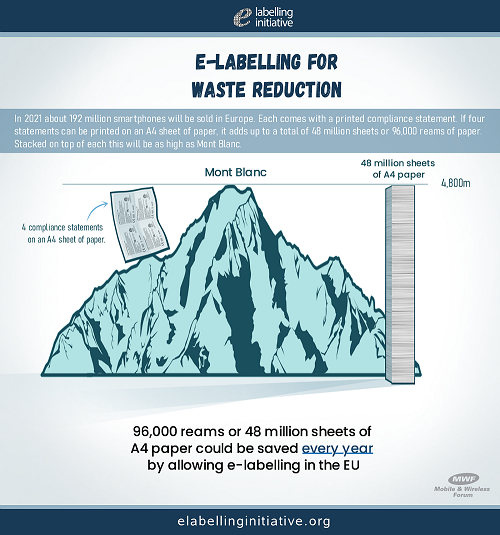Have you recently purchased an electronic device such as a mobile phone, tablet, or laptop? If you have, there will have been additional labelling or safety information provided with the product. This may have been in the form of the CE mark etched onto the product and a sheet or more of printed material inside the packaging.
If you did not read that information, you are not alone. Every year, most consumers discard the safety and compliance information with the packaging from the device.
Now, manufacturers and campaigners are pressing the European Union to amend regulations to modernise how compliance and safety information is provided.
One of the key bodies campaigning for change is the Mobile and Wireless Forum (MWF). The MWF is an international association of companies active in the mobile and wireless communications sector. They launched the E-Labelling Initiative (ELI) to press for change when it comes to the labelling of electronic goods within the EU.
Michael Milligan, Secretary General at MWF told The Parliament Magazine that there are strong arguments for change.
“Essentially the current system is an analogue model in a digital world,” he explains. “Moving away from printed material and having the compliance information accessible from the device itself avoids waste and ensures greater availability, accessibility, and traceability. This makes e-labelling a smarter, greener alternative for modern businesses and consumers.”

Removing the need for printed information might seem like a relatively minor issue for a focused campaign. However, the sheer volume of sales of electronic devices means that the inclusion of physical information with electronic goods adds costs for manufacturers and has a significant environmental impact. This is because every piece of printed information requires paper, ink, other materials, and transportation. This contributes to deforestation, pollution, and wider environmental damage.
In fact, the MWF estimates that including printed compliance information just for smartphones in the European Union accounts for 4800 trees each year. Producing those pieces of paper requires 480 million litres of water. Transporting them creates around 1000 tonnes of CO2.
E-labelling for electronic devices would be a step towards a more digitalised European Union, which is our common goal
Ivan Štefanec MEP
In a world where we are increasingly conscious of the need to safeguard the environment, that is a lot of paper, water, and energy.
And this is not just an environmental issue. There are problems for consumers too. Information may not be in a format or a language that they understand, cannot be updated in line with changing regulations, can be easily misplaced, and will not be passed on if the goods are resold.
This range of challenges is why some voices are now calling for a modernisation of the rules around the labelling of radio equipment. This could, they argue, reduce the environmental impact of providing compliance information and give more clarity to consumers.
“It is important to realise that by the implementation of the e-labelling system, the consumer will have access to more detailed and expanded information about the product,” MEP Ivan Štefanec explains. “This is simply not possible with physical labelling. Moreover, it would also be a step towards a more digitalised European Union which is our common goal."
It is an issue where the EU is increasingly out of step with competitors and trading partners. The benefits of e-labelling have already led to its adoption in other countries for products such as tablets and mobile phones. However, current EU rules still require the production and addition of physical information, creating a challenge for companies operating within a global market.
“The current system for demonstrating compliance under the radio equipment directive in Europe is based on physical, printed labels or having the CE mark printed or etched on the product,” explains Milligan. “This information is rarely if ever, read by consumers.”
Experts believe that the rapid expansion of new technology demands new solutions that protect consumers and provide information in a clear and accessible way.
Developing these solutions can draw upon learning from countries such as the United States, China, Japan, South Korea, and Taiwan. All of these nations have already made the move to replace traditional labelling requirements with the option to use electronic labelling for mobile phones and other ICT equipment, such as tablets, wearables, and laptops.
“There are lots of advantages to manufacturers and retailers,” Milligan tells us. “But there is also a wealth of benefits for consumers too. With smartphones in particular, we know that a simple link can display the relevant information to the consumer visually and in any language. Not only is this more environmentally sustainable, but it also ensures that as regulations change information can be updated in real-time.”
Campaigners calling for changes to regulations to allow e-labelling on electronic devices point out that the principle of e-labelling has already been accepted across the EU in a range of other areas. This is a view shared by some legislators.
"The European Commission has already supported e-labelling in other sectors,” MEP Ivan Štefanec explains. “I personally don’t see a reason why electronic devices should be an exception.”
The evidence supports Štefanec’s view. In sectors such as marine and chemicals, the shift to e-labelling has been seamless. It has resulted in reduced environmental impact, financial savings, and has ensured that important information is fully accessible to the end users and other key stakeholders such as customs and market surveillance authorities.
“The arguments for introducing e-labelling within the European Union are compelling,” Milligan tells us. “It can reduce our environmental impact, improve convenience for consumers, save manufacturers time and money, and improve the accuracy and reliability of information. Surely now is the time for the EU to embrace e-labelling for electronic devices and move towards a more sustainable and environmentally friendly future.”
Find out more at www.elabellinginitiative.org/
Sign up to The Parliament's weekly newsletter
Every Friday our editorial team goes behind the headlines to offer insight and analysis on the key stories driving the EU agenda. Subscribe for free here.